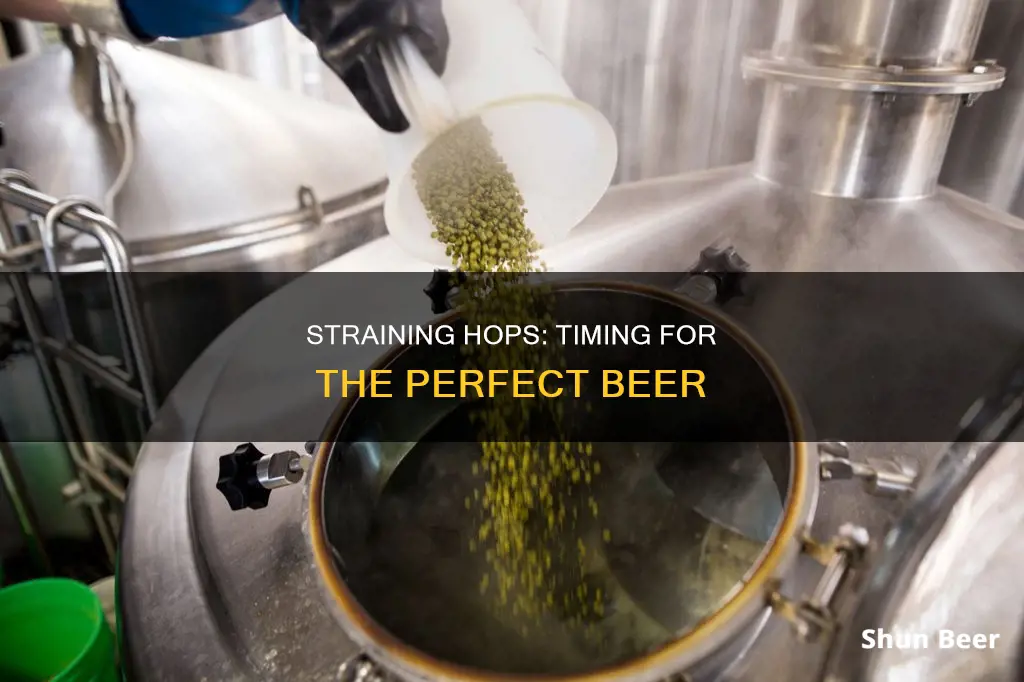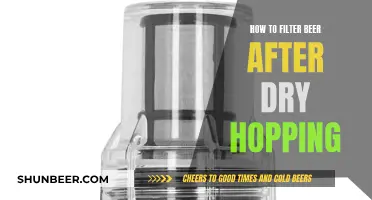
Hops are a key ingredient in beer, adding bitterness, flavour and aroma. But when do you strain them out? The answer depends on the type of hops and the brewing process. Whole hops are typically removed before fermentation, as they don't break down as much as pellet hops and can cause issues like clogging equipment, clouding your beer, and taking up too much space in your fermentation vessel. Pellet hops, on the other hand, tend to dissolve during the boil and settle at the bottom of the kettle, so they can be left during fermentation and simply siphoned off when transferring to the fermentor. Using a hop bag or spider can also make it easier to remove hops, either during or immediately after the boil.
| Characteristics | Values |
|---|---|
| When to strain hops out of beer | After boiling the hops |
| Why strain hops out of beer | To prevent clogging of equipment, clouding of beer, and taking up space in the fermentation vessel |
| How to strain hops out of beer | Using a hop bag, hop spider, whirlpool method, cheesecloth, funnel with strainer, mesh strainer, hop filter bag, paint strainer, copper scrubber, hop stopper, bazooka screen, false bottom |
What You'll Learn
- Hop bags are a simple way to strain hops out of beer
- Hop spiders are a reusable alternative to hop bags
- Using a whirlpool method can help hops settle at the bottom of the kettle
- A mesh strainer is a simple solution to filtering hops
- Straining hops before fermentation prevents clogging and clouding issues

Hop bags are a simple way to strain hops out of beer
Using a hop bag is straightforward. Simply put your hops in the bag, add the bag to your brew at the appropriate time during the boil, and then remove it when you are done. This process helps to contain the hops and makes it easier to remove them when you are finished brewing. It also reduces the amount of straining required when transferring your fresh wort into the fermenter, resulting in clearer beer.
In addition to their convenience, hop bags offer versatility in brewing. They can be used not only for hops but also for steeping specialty grains or containing adjuncts such as orange peel, coffee beans, or cacao nibs to enhance the flavour of your brew. This allows you to experiment with different ingredients and create unique and interesting beers.
When using a hop bag, it is important to sanitise it before each use to ensure a sterile brewing environment. This can be done by immersing the bag in boiling water for a few minutes or following other sanitising procedures recommended by the manufacturer. Remember to handle the bag with clean utensils or tongs to avoid introducing contaminants.
By utilising hop bags, you can streamline your brewing process, reduce mess, and focus on crafting delicious beers.
Zywicki Portor Beer: Hops or No Hops?
You may want to see also

Hop spiders are a reusable alternative to hop bags
When brewing beer, hops can be added at different stages of the process, including during the mash, before the boil, during the boil, post-boil, during fermentation, and after fermentation. However, the question remains: when should the hops be strained out of the wort or beer?
Some brewers choose to remove the hops at the end of the boil, particularly if they are using a hop bag or hop spider. Leaving the hops in the wort during fermentation is generally not recommended, as they add nothing to this process and can create a mess. Additionally, hops added to the boil are usually left behind when transferring the wort to the fermenter.
Now, let's talk about hop spiders and how they compare to hop bags. Hop spiders are a type of containment method used during the boil to aid in cleanup and facilitate easy removal of hops. They are typically set up on the kettle, with a bag attached to a piece of PVC pipe that suspends above the wort. While hop spiders make cleanup more manageable, they may not be ideal for large hop charges during the whirlpool stage, as they can be difficult to agitate without a recirculating pump.
On the other hand, hop bags are also used to contain hops during the boil, and they can be effective in reducing wort loss. However, there is a debate among brewers about whether using a hop bag restricts the utilisation of hops, as the hops are not free-floating in the wort. Some brewers prefer to use a combination of methods, such as a whirlpool, to separate the hops and trub from the wort before transferring it to the fermenter.
Ultimately, the decision between using a hop spider or a hop bag depends on the brewer's priorities. Hop spiders excel in making cleanup easier, while hop bags may provide more contact between the hops and the wort. However, there is limited scientific evidence to suggest that one method produces significantly better beer than the other.
Malt, Hops, and Sours: What's the Deal?
You may want to see also

Using a whirlpool method can help hops settle at the bottom of the kettle
Hops are an essential ingredient in beer, providing bitterness, flavour, and aroma. However, they are not intended to be consumed, and so brewers must find ways to separate the hops from the beer before serving. One way to do this is by using a whirlpool method, which can help hops settle at the bottom of the kettle.
The whirlpool method involves creating a circular current in the brew kettle, which can be done using various techniques and equipment. The simplest way is to stir the kettle's contents rapidly with a spoon until a circular current is achieved. This can be done while the wort is cooling, and it is important to stir along the walls of the kettle to avoid splashing, which could cause hot-side aeration.
Another way to create a whirlpool is to use a pump or counterflow chiller. This involves angling the pump-out hose along the side of the kettle a few inches below the surface of the wort, which will cause the wort to spin in a circular current. It is important to be careful when using a pump as it can cause hot wort to splash out of the kettle.
Whirlpooling has several benefits in addition to helping hops settle. It can also speed up the chilling process by constantly churning and combining the cool and warm wort. Additionally, it promotes clearer wort by collecting the cold break solids in the centre of the brew kettle, allowing the clearer wort to be siphoned off from the side.
Whirlpooling can also improve hop flavour and aroma. By cooling the wort faster, post-boil hop additions instil more flavour and aroma without too much bitterness. This is because hops continue to isomerize—the process that attaches alpha acids to water molecules, creating bitterness—above 180°F (82°C). Whirlpooling allows brewers to drop the temperature below this point quickly, preventing isomerization in hop additions that are intended to add just flavour and aroma.
In conclusion, the whirlpool method is an effective technique for helping hops settle at the bottom of the kettle, and it offers several other benefits that can improve the quality of the final beer.
Hop Springs Beer Park: A Fun-Filled Adventure
You may want to see also

A mesh strainer is a simple solution to filtering hops
Filtering hops out of beer is a crucial step in the brewing process, as it helps to clarify the beer and prevent clogging issues in fermentation and chilling equipment. While there are various methods for achieving this, one of the simplest and most accessible solutions is to use a mesh strainer.
A mesh strainer is a common kitchen tool that can be easily adapted for hop filtration. Its fine mesh effectively captures the hops, separating them from the wort. This is particularly advantageous when using whole hops, as the mesh allows the hops to “swim free” and release their desired flavours into the beer. However, it is important to note that pellets can quickly clog the strainer, requiring frequent rinsing during the process.
One of the benefits of using a mesh strainer is its ease of use. Simply place the strainer over your fermenting bucket or kettle, and pour the wort through it. This will catch the hops and any other sediment, leaving you with a clearer wort. Additionally, mesh strainers are easy to sanitise, an important step in the brewing process to prevent contamination.
For those brewing alone, a mesh strainer can be a bit cumbersome to manage, as it requires holding it in place while transferring the wort. However, this can be overcome with a bit of creativity and improvisation. Some brewers have found success by combining the mesh strainer with other methods, such as the whirlpool technique, where the wort is stirred to collect the hops and sediment in the centre of the kettle, making it easier to draw off the liquid from the sides.
When it comes to choosing a mesh strainer, stainless steel options are ideal as they are rust-proof, hot-resistant, and have a long service life. Additionally, look for a strainer with a fine mesh, around 300 microns, to effectively capture the hops and other particles.
In conclusion, a mesh strainer is a straightforward and cost-effective solution for filtering hops when brewing beer at home. It helps to clarify the wort, prevent clogging, and improve the overall brewing process. While it may require some adjustments and additional techniques, the mesh strainer is a versatile tool that can be easily incorporated into your home brewing setup.
Hoppy Beer, Happy Life: The Ultimate Guide to Hopping
You may want to see also

Straining hops before fermentation prevents clogging and clouding issues
Brewing beer is a delicate process that requires attention to detail, especially when it comes to the use of hops. Hops are a key ingredient in beer, providing bitterness, flavour, and aroma. However, leaving hops in the wort during fermentation can cause issues, which is why many brewers choose to strain hops before this stage.
One of the main benefits of straining hops before fermentation is preventing clogging problems. During the boil, hops break down and form a thick residue called "trub," which can clog equipment, especially the hoses used for transferring beer to the fermenter and during bottling. Straining hops before fermentation reduces the risk of clogging and makes the brewing process smoother.
Another issue that straining hops can prevent is clouding in the final beer product. If hops are not strained before fermentation, they can get agitated and mixed into the wort, resulting in a cloudy appearance. While this may not affect the taste, it can be undesirable for certain beer styles. Straining hops helps ensure a clear, crisp beer.
Additionally, straining hops before fermentation saves space in the fermentation vessel. Hops take up valuable room that could be used for brewing more beer. By removing the hops, brewers can maximize the efficiency of their fermentation process and produce more beer in each batch.
The type of hops also plays a role in the decision to strain before fermentation. Hop pellets, for example, are more prone to contributing to trub and should always be removed before fermentation if possible. Whole hops, on the other hand, can be used dried or fresh and are easier to spot and remove due to their larger size.
There are several methods for straining hops, including using a hop bag, a hop spider, or a whirlpool technique. A hop bag is like a large tea bag for hops and can be tied to the brew kettle handles. A hop spider is a reusable metal strainer that attaches to the edge of the brew kettle. The whirlpool method involves manually stirring the chilled wort to form a whirlpool, causing the hop trub to settle at the bottom, which can then be siphoned off.
While leaving hops in during fermentation may not ruin a batch of beer, straining them beforehand can improve the overall quality and consistency of the final product. By preventing clogging, clouding, and space issues, brewers can ensure a smoother brewing process and a clearer, more aesthetically pleasing beer.
Hops-Free Brews: Exploring the World of Hopless Beers
You may want to see also
Frequently asked questions
Hops should be strained out of the beer before proceeding with fermentation. This is because the hop trub or residual hop debris can cause issues like clogging equipment, clouding your beer, and taking up too much space in your fermentation vessel.
The two most common and easy-to-use tools for removing hops are hop bags and hop spiders. A hop bag is a mesh bag that you can use to contain your hops during the boil. A hop spider is a reusable alternative to a hop bag, which is an open-topped cylindrical metal strainer that attaches to the edge of your brew kettle.
If you don't strain the hops out of your beer, it will almost never ruin a batch. However, their presence may make bottling more challenging, and they can cause issues like clogging equipment and clouding your beer.







